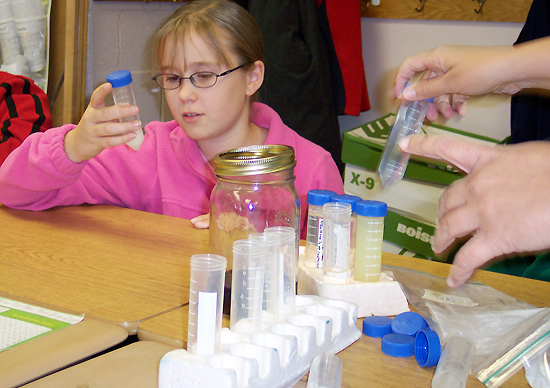Wesleyan Science Program Energizes Local Elementary School Class
 |
| At top, fifth grader Taylor Spencer learns about the hydrogen make-up of vinegar, club soda and ammonia with Manju Hingorani, assistant professor of molecular biology and biochemistry at Spencer Elementary School Nov. 10. (Photo by Olivia Drake) |
| Posted 11/16/05 |
| When 18 fifth graders from the Spencer School in Middletown came home on Nov. 10 and were asked, What did you do in school today? they had a few ready answers:
We extracted DNA from wheat germ, checked hydrogen levels in household products and stripped-away pigments from M&M candies. Probably a little different from the responses parents had heard the day before. The extracting, checking and stripping-away came courtesy of an all-female Wesleyan faculty and student organization called Action Science Kids (ASK), which is part of the Wesleyan Women in Science program (WesWIS). One of ASKs goals is to generate interest in science among the elementary school-aged students, as well as to demonstrate to girls and boys that the sciences are not only accessible to men. The idea is to infuse a notion of intelligent, competent women in various scientific fields, said Kate Longley, a ASK member and Wesleyan senior biology major from Delmar, N.Y. The Nov. 10 demonstration in Mrs. Greenlaws homeroom class was ASKs most recent effort. Students and volunteers were divided up into groups and participated in the three different science experiments. Manju Hingorani, assistant professor of Molecular Biology & Biochemistry, led an experiment where she explained how common household products like vinegar, aspirin and ammonia, among others, contain different levels of hydrogen. When mixed with red cabbage juice, students determined that the pink mixtures, like vinegar, contained more hydrogen than the green mixtures like ammonia. Learning how to engage such a young audience in scientific discussions is quite an experience, says Hingorani. She adds that she enjoys the presentations and is hoping more Wesleyan students will get involved with the ASK program. It is very effective to show kids that, at any age, how much fun they and grown-ups can have with scientific experiments, she explained. Emily Alexy, a Wesleyan senior and math major from Ohio, worked on the experiment extracting DNA from wheat germ. Does anyone know what DNA does? she asked. Its like a recipe for something and tells your body what youre going to look like. Alexy discussed DNA and its functions, using common items, like soap, rubbing alcohol and water. In her experiment, DNA strands bubbled up to the top of the students test tubes when they mixed soap with wheat germ, warm water, meat tenderizer and baking soda. One of the students, a 10-year-old named Eleanor, grew excited when her DNA strand fizzed to the top of her test tube. I like science because you get to learn about your world and earth you live in! she exclaimed. Samsun Nahar, a freshman from Manchester, Conn. presented an experiment called candy chromatography. She led students through rubbing coffee-filter paper across the candy coating of brown M&Ms, brown Reeses Pieces candies and purple jellybeans to observe their different color coatings and dyes. For more information about ASK contact Manju Hingorani at 860-685-2284 or mhingorani@wesleyan.edu. |
| By Laura Perillo, associate director of Media Relations |

